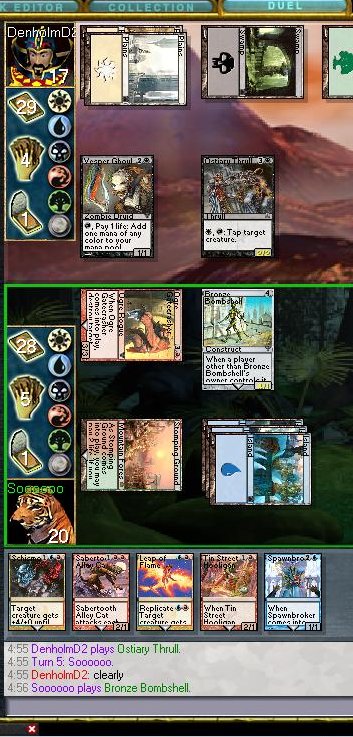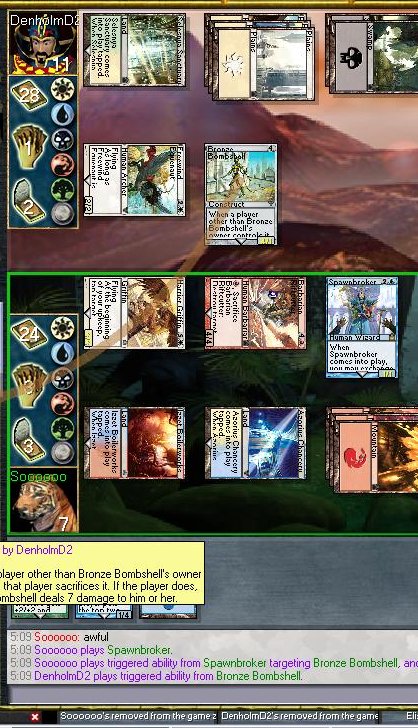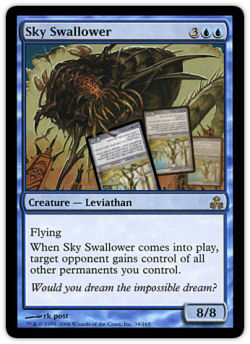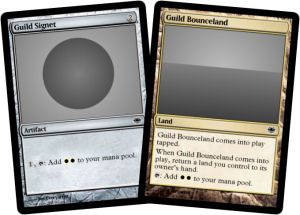With the Sealed PTQ season still in full swing, and Grand Prix St. Louis on the horizon, I decided it was about time I wrote an article on Ravnica Sealed.
But first, something completely different.
Game 1 Screenshot

Game 2 Screenshot

As you can see, I’ve managed to “live the dream.” These screenshots came from an 8-4 draft I did this week in which my deck ended up quite poor, but did manage to accomplish its one purpose in life: getting off the Bombshell plus Spawnbroker combo!
TWICE!
In game 1 I traded my opponent Bombshell for his Ostiary Thrull and still almost managed to lose because my deck was so bad. After he killed all of my guys except a lone Ogre Gatecrasher, I Leap of Flamed it and Schismotivated over the top for the win, which put him on full blown tilt. Game 2 was a different story as I gave him Bombshell for Harrier Griffin and was never close to losing. This is without mentioning, however, that he chump-blocked with his Thoughtpicker Witch or else I wouldn’t have even been able to initiate the tradeoff.
Needless to say, my opponent called me everything in the book and told me how terrible I was while I was busy dying of laughter.

If anyone manages to accomplish a multiple Bronze Bombshell tradeoff involving Sky Swallower in a draft, please don’t hesitate to write about it, or at least email me some screenshots.
I guess I should move on to actual strategy, now and talk about some Sealed Deck tactics.
General Strategy
Lots of articles have already been written on this subject, and I’m going to try as hard as I can to try and not overlap too much information. That said, I have some rules that I try to follow when building decks in this format, as a number of things are usually true in terms of what my opponents are doing.
Build for power, but don’t sacrifice consistency.
The majority of the field in RGD Sealed is building three-color decks with a small splash if necessary. Sure, you’ll see the occasional five-color build because of good mana, or even the straight three-color or two colors with a splash, but four-color decks are the norm in the format.
The first step of understanding is for you to realize that the reason this is happening is because everyone wants to play as much removal as possible, as long as they have the manafixing to go with it. It’s a very removal-oriented format, and you should build with that in mind. Things like Magemarks lose a lot of value in that sense, though the Blue one is still strong and I like it even more as a sideboard option when you happen to run into someone who doesn’t have six removal spells in his deck.
The second step is for you to analyze your card pool and see if there is a way you can build a strong deck that is not so shaky in the mana department. This is the same theory I’ve been writing about in draft, where my advice is to try and draft RG or BW aggro and punish people for playing slow decks and bad manabases. In Sealed, your options are much more limited, as you can’t set yourself up like you can in a draft and you only have the cards you open to work with.
RGD Sealed is a combination of building for power and also building to maximize your effectiveness against people who are stretching their deck too thin. This is the balance that gives better players an edge against someone who simply opened a better card pool.

When in doubt, go with the manafixing.
A few times I’ve opened up a cardpool that literally could be built five or six different ways and still be very competitive. These pools can cause some real headaches if you don’t know what forty cards to choose, and I’ve noticed that a lot of them have something in common. With similar card quality spread among the colors, you should try to pack in as many good cards as you can without stretching the mana and by abiding by your bounce lands and signets. Even if you have better overall card quality than someone you’re playing against, you can lose games just because they have bounce lands and you don’t and you end up getting manaflooded far more often than they do. This is why when you’re unsure of a direction to take with a Sealed pool, you should tend to follow your bounce lands and play the maximum number possible.
Play the off-color bounces.
Not much to say here except that at GP Toronto plenty of people kept coming up to me and asking if they built their deck right, and I would immediately notice that they had a bounce land in their sideboard that they could’ve played even if it didn’t help with both colors. This is an easy mistake not to make, as the only time you shouldn’t include one of these “off-color” bounces is when your mana curve simply doesn’t permit it (this doesn’t happen often, and has never happened to me).
“The Usuals” still apply.
Even if your creatures aren’t the greatest things in the world, you should still have plenty to get the job done. What I mean by this is that when your opponent has a more powerful deck than you do, you want to make sure you curve out guys to give yourself the best chance of winning before his more powerful spells take effect. Flying is also extremely important in this format, and even if your deck is otherwise mediocre, if you have a good air force with some removal you should be in good shape. By the same token, you should be prepared to stop opposing fliers, and there are certainly plenty of good ways to do so, especially in Green.
Remember too that because this format is so removal heavy with everyone playing four colors, the old tricks of baiting out removal spells with weaker creatures, and slow-rolling Auras like Ocular Halo until the best possible moment, are very important.
A Sample Sealed Pool
Ninety players signed up for the Sunday afternoon Premiere Event a couple of weeks ago, and here’s the card pool I opened.
Creatures (43)
- 1 Snapping Drake
- 1 Auratouched Mage
- 1 Barbarian Riftcutter
- 1 Boros Recruit
- 1 Carven Caryatid
- 1 Courier Hawk
- 1 Drake Familiar
- 1 Golgari Rotwurm
- 1 Golgari Thug
- 1 Grave-Shell Scarab
- 1 Greater Mossdog
- 1 Guardian of Vitu-Ghazi
- 1 Infectious Host
- 1 Leashling
- 1 Lore Broker
- 1 Moroii
- 1 Necroplasm
- 1 Ordruun Commando
- 1 Sabertooth Alley Cat
- 1 Siege Wurm
- 1 Stinkweed Imp
- 1 Stone-Seeder Hierophant
- 1 Terraformer
- 1 Tidewater Minion
- 1 Transluminant
- 1 Viashino Fangtail
- 1 Blind Hunter
- 1 Bloodscale Prowler
- 1 Burning-Tree Bloodscale
- 1 Crystal Seer
- 1 Dune-Brood Nephilim
- 1 Lionheart Maverick
- 1 Silhana Starfletcher
- 1 Skarrgan Pit-Skulk
- 1 Wee Dragonauts
- 1 Aquastrand Spider
- 1 Assault Zeppelid
- 1 Dread Slag
- 1 Drekavac
- 1 Enigma Eidolon
- 1 Silkwing Scout
- 1 Sporeback Troll
- 1 Whiptail Moloch
Lands (4)
Spells (28)
- 1 Boros Fury-Shield
- 1 Cleansing Beam
- 1 Consult the Necrosages
- 1 Dimir Signet
- 1 Festival of the Guildpact
- 1 Fiery Conclusion
- 1 Gather Courage
- 1 Leave No Trace
- 1 Moldervine Cloak
- 1 Quickchange
- 1 Rain of Embers
- 1 Selesnya Signet
- 1 Shred Memory
- 1 Spectral Searchlight
- 1 Stasis Cell
- 1 Surge of Zeal
- 1 Three Dreams
- 1 Wojek Siren
- 1 Cry of Contrition
- 1 Electrolyze
- 1 Repeal
- 1 Shattering Spree
- 1 Thunderheads
- 1 Kindle the Carnage
- 1 Macabre Waltz
- 1 Shielding Plax
- 1 Steeling Stance
- 1 Valor Made Real

Mandatory blank space for you to build the deck…
…
…
…
…
…
…
P.S. Bombshell you?
…
…
…
…
…
…
Annnd, here’s what I ended up with, followed by some explanations.
Creatures (17)
- 1 Snapping Drake
- 1 Carven Caryatid
- 1 Golgari Rotwurm
- 1 Grave-Shell Scarab
- 1 Greater Mossdog
- 1 Guardian of Vitu-Ghazi
- 1 Moroii
- 1 Siege Wurm
- 1 Stinkweed Imp
- 1 Transluminant
- 1 Blind Hunter
- 1 Crystal Seer
- 1 Silhana Starfletcher
- 1 Aquastrand Spider
- 1 Assault Zeppelid
- 1 Silkwing Scout
- 1 Sporeback Troll
Lands (15)
Spells (8)

Some things definitely deserve explanation as this pool was different from most that I’ve seen.
First off, the deck has zero removal. This is a bad thing in a format based on removal, but I simply couldn’t find a way to fit the Red cards in the deck and still get a good manabase and consistent build. This deck has tons of awesome fliers, as well as Moldervine Cloak, and just tries to win through brute force. Anyone who has suggestions for building it differently color-wise is more than welcome to share them in the forums.
Fifteen Lands? Are you insane?
Maybe. But that’s the topic of another article.
One of the last things I decided to do was to cut the sixteenth land and add Selesnya Signet and swap around a few cards. I took out the Tidewater Minion for Crystal Seer, which I’ll explain below and I also added Guardian of Vitu-Ghazi into the deck. With three bounces, two Signets, Spectral Searchlight, and Starfletcher, I felt fifteen was more than enough. I also couldn’t afford to get manaflooded as I didn’t really have anything to pull myself out of it and as I already mentioned, I had no removal.
Guardian of Vitu-Ghazi
This guy is excellent in Sealed, especially on the splash. Most decks have a lot of trouble dealing with him, and he should be able to hold the ground while my fliers win in the air. The nice thing with this deck is that he’s essentially a free splash with the two bouncelands, Selesnya Signet, Searchlight, and Starfletcher.
Crystal Seer
I’ve always really liked this guy in Sealed as he helps you get to your good stuff and can also be re-used since many games will go long. I replaced Tidewater Minion with him since I didn’t have any abilities to abuse with the Minion, and the Seer is also easier on the mana.
Necroplasm, Tidewater Minion, and Enigma Eidolon were all considerations for the deck, but didn’t end up making it. Necroplasm because of the mana, Eidolon because it wasn’t that great unless I also drew Grave-Shell Scarab, and I’ve already explained the Minion.
This pool is an example of going with the mana rather than stretching it by splashing Cleansing Beam, Fiery Conclusion, and Electrolyze with no way to fix them besides Starfletcher and Searchlight. My thinking in building this deck was that I needed to cast big fliers quickly, or win with Moldervine Cloak before my opponent had time to properly set up his better spells. The White splash for Blind Hunter and Guardian of Vitu-Ghazi was basically free because of the bounces and the Signet.
While I still feel like I built this deck correctly, things didn’t go according to plan in the actual matches so I decided to use the card pool for this article to see if someone else had different ideas on how to build the deck.
Round 1 against Goochie
Game 1 I start off with Dimir Signet, Silkwing Scout, and then Cloak it up on turn 4. Goochie’s answer to this is to play out Benevolent Ancestor and Drift of Phantasms, and quickly we’ve entered a stalemate. I continue building up guys and eventually draw into Golgari Rotwurm. My team consists of Assault Zeppelid, Mossdog, Siege Wurm, the cloaked Scout, and Blind Hunter, and I decide to send everyone into his superior creatures and then just win with Rotwurm and Blind Hunter. This ends up working because he can’t block the Siege Wurm effectively on the first turn, and I have enough to drain him out.
Game 2 my draw is slower, and I start with Spectral Searchlight and a couple of bouncelands before playing Crystal Seer and then suiting it up with the Cloak. He is trying to race with Dimir Infiltrator plus Ghost Warden, and hit me once with Conclave Equenaut before my Stinkweed Imp stopped that nonsense. After I hit him with the Crystal Seer for the second time, I had just drawn the Rotwurm that I stacked as the second card down from Seer and was planning to drain him out again. Anyway, on the turn that I could kill him, I ended up being one mana short since I had to Dredge back Stinkweed Imp and then play Greater Mossdog, and could only use the Rotwurm ability twice with him on three life. Well, apparently he was slow-rolling Disembowel and killed the Rotwurm on his turn (?) Seemed like an awfully dangerous idea if you ask me, as if I had something smaller than a four drop he was just dead. Anyway, his alpha strike put me to two, and I didn’t have enough mana to Waltz back my Rotwurm and kill him since I could only drain him once because I needed the Stinkweed in play to survive his attack.
Game 3 I start again with the Cloak on Silkwing Scout (I know, how lucky) and he doesn’t have a whole lot of resistance this game after he plays Demon’s Jester and then puts Strands on it, only to see me Repeal it and hit him for five. I end up playing Moroii as well, and kill him with Gather Courage when he can only block one flier.
1-0
Round 2 against Tori
Game 1 I lose to Clutch of the Undercity on a critical turn, which bounces my Guardian of Vitu-Ghazi that I had Grafted onto from Aquastrand Spider with the intention of stopping oncoming fliers. I had Moroii on the attack, and I think I still would’ve won this game if the Clutch didn’t also make me lose three life.
Game 2 I mulligan to four on the draw, and despite playing Assault Zeppelid on turn 4, I’m still crushed easily by his own Assault Zeppelid, Snapping Drake, and Gruul Guildmage.
1-1
Round 3 against forgot to write down your name.
This match showcased some of the luck factor involved in RGD Sealed as my opponent completely destroyed me both games with Twinstrike, Niv-Mizzet, and Demonfire along with other removal like Douse and Last Gasp. There was really nothing I could do against this quality of a card pool, since I had no way to stop his bombs. The same type of thing happened to me in the PTQ on Day 2 of GP Toronto, as I managed to go 5-1 with an awful card pool only to lose to Selesnya Guildmage and Glare near the end of the tournament.
1-2 drop
While I didn’t do particularly well in this tournament, there is still plenty to learn from it.
Did I build the deck wrong or was there simply nothing I could do about it? See you in the forums.
Nick Eisel
[email protected]
Soooooo on MODO
P.S. Demonfire you, Bombshell you, etc.
